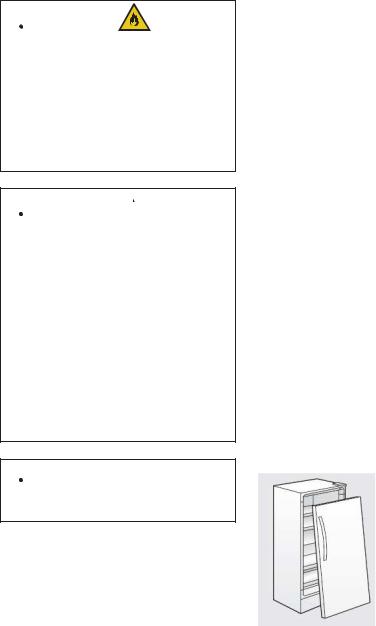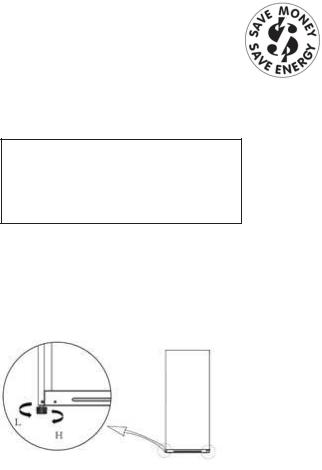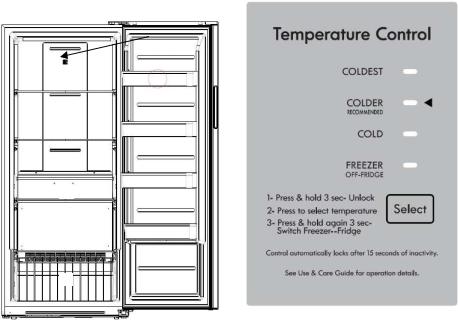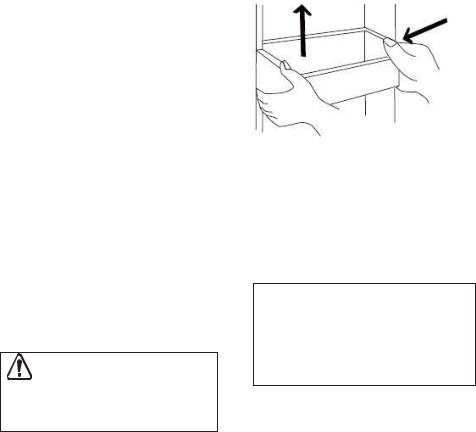Kenmore 11122172910, 11121202910 Owner’s Manual

Use & Care Guide
Manual de Uso y Cuidado
Kenmore®
Upright Freezer/
Refrigerator
Congelador/ Refrigerador vertical
Models/Modelos: 111.21202 – White – 21 cu. ft. 111.22172 – White – 17 cu. ft.
Transform SR Brands Management
Hoffman Estates, IL 60179 U.S.A.
www.kenmore.com
®

Record Model/
Serial Numbers
Please read and save these instructions
This Use & Care Guide provides specific operating instructions for your model. Use your unit only as instructed in this guide. These instructions are not meant to cover every possible condition and situation that may occur. Common sense and caution must be practiced when installing, operating, and maintaining any appliance.
Please record your model and serial numbers below for future reference. This information is found on the lower left wall inside the appliance.
Model Number: 111.
or |
|
Serial |
Number: Purchase
Date:
IMPORTANT
Use only soap and water to clean serial plate.
Important Safety
Instructions
Safety Precautions
Do not attempt to install or operate your unit until you have read the safety precautionsin this Use & Care Guide. Safety items throughout this manual are labeled with a Danger, Warning, or Caution based on the risk type.
Definitions
 This is the safety alert symbol. It is used to alert you to potential personal injury hazards. Obey all safety messages that follow this symbol to avoid possible injury or death.
This is the safety alert symbol. It is used to alert you to potential personal injury hazards. Obey all safety messages that follow this symbol to avoid possible injury or death.
 DANGER
DANGER
DANGER indicates an imminently hazardous situation which, if not avoided, will result in death or serious injury.
 WARNING
WARNING
WARNING indicates a potentially hazardous situation which, if not avoided, could result in death or serious injury.
Table of Contents |
|
Record Model/Serial Numbers |
................... 2 |
Important Safety Instructions....................... |
2 |
Appliance Setup............................................. |
5 |
Appliance Use................................................. |
6 |
Temperature Control...................................... |
6 |
Care & Cleaning............................................. |
7 |
Power or Appliance Failure.......................... |
8 |
Before You Call............................................... |
9 |
Warranty......................................................... |
11 |
Service............................................. |
Back Cover |
 CAUTION
CAUTION
CAUTION indicates a potentially hazardous situation which, if not avoided, may result in minor or moderate injury.
IMPORTANT
Indicates installation, operation, or maintenance informationwhich is important but not hazard-related.
2

Important Safety Instructions
 DANGER
DANGER
DANGER Risk of fire or explosion. Flammable refrigerant used. Do not use mechanical devices to defrost refrigerator. Do not puncture refrigerant tubing.
DANGER Risk of fire or explosion. Flammable refrigerant used.To be repaired only by trained service personnel. Do not puncture refrigerant tubing.
 CAUTION
CAUTION 
CAUTION Risk of fire or explosion. Flammable refrigerant used. Consult repair manual/owner’s guide before attempting to service this product. All safety precautions must be followed.
CAUTION Risk of fire or explosion. Dispose of properly in accordance with federal or local regulations. Flammable refrigerant used.
CAUTION Risk of fire or explosion due to puncture of refrigerant tubing. Follow handling instructions carefully. Flammable refrigerant used.
 WARNING
WARNING
Read all safety instructions before using your new appliance.
For Your Safety
•Do not store or use gasoline or other flammable liquids in the vicinity of this or any other appliance. Read product labels for warnings regarding flammability and other hazards.
•Do not operate the unit in the presence of explosive fumes.
•Remove and discard any spacers used to secure the basket during shipping. Small
objects are a choke hazard to children.
•Remove all staples from the carton. Staples can cause severe cuts and also destroy finishes if they come in contact with other appliances or furniture.
Child Safety
Destroy or recycle the carton, plastic bags, and any exterior wrapping material immediately after the unit is unpacked. Children should never use these items to play. Cartons covered with rugs, bedspreads, plastic sheets or stretch wrap may become airtight chambers and can quickly cause suffocation.
Proper disposal of your appliance
 DANGER: Risk of child entrapment!
DANGER: Risk of child entrapment!
Child entrapment and suffocation are not problems of the past. Junked or abandoned appliances are still dangerous – even if they will sit for “just a few days.” If you are getting rid of your appliance, please follow the instructions below to help prevent accidents.
Before you throw away your old unit:
•Remove door.
•Leave shelves in place within appliance so children may not easily climb inside.
•Have refrigerant removed by a qualified service technician.
3

Important Safety Instructions
IMPORTANT
Your old unit may have a cooling system that used CFCs or HCFCs (chlorofluorocarbons or hydrochlorofluorocarbons).
CFCs and HCFCs are believed to harm stratospheric ozone if released to the atmosphere. Other refrigerants may cause harm to the environment if released to the atmosphere. If you are throwing away your old unit, make sure the refrigerant is removed for proper disposal by a qualified technician. If you intentionally release refrigerant, you may be subject to fines and imprisonment under the provisions of environmental legislation.
 WARNING
WARNING
These guidelines must be followed to ensure that safety mechanisms in this unit will operate properly.
Electrical Information
•The unit must be plugged into its own dedicated 10 amp minimum, 115 Volt, 60 Hz, AC only electric outlet. The power cord of the appliance is equipped with a three-prong grounding plug to protect against shock hazards. It must be plugged directly into a properly grounded threeprong receptacle. The receptacle must be installed in accordance with local codes and ordinances. Consult a qualified electrician. Do not use an extension cord or adapter plug.
•Immediately repair or replace any power cord that becomes frayed or damaged.
•Never unplug the appliance by pulling on the power cord. Always grip the plug firmly, and pull straight out from the receptacle to prevent damaging the power cord.
•Unplug the appliance before cleaning and before defrosting to avoid electrical shock.
4
•Performance may be affected if the voltage varies by 10% or more. Operating the unit with insufficient power can damage the motor. Such damage is not covered under the warranty.
•Do not plug the unit into an outlet controlled by a wall switch or pull cord to prevent the appliance from being turned off accidentally.
•Avoid connecting unit to a Ground Fault Circuit Interruptor (GFCI).

Appliance Setup
This Use & Care Guide provides specific operating instructions for your model. Use the unit only as instructed in this Use & Care Guide. Before starting the appliance, follow these important setup steps.
Installation
•Choose a place that is near a grounded electrical outlet. Do Not use an extension cord or an adapter plug.
•For the most efficient operation, the appliance should be located where surrounding temperatures will not exceed 110°F (43°C). Temperatures of 32°F (0°C) and below will NOT affect appliance operation. Additional compressor heaters are not recommended.
•Allow space around the unit for good air circulation. Leave a 1-inch (25.4 mm) space at the back and on top and a 3/8-inch (9.5 mm) space on the sides of the appliance for adequate circulation.
Leveling
The appliance must have all bottom corners resting firmly on a solid floor that is strong enough to support a fully loaded appliance.
It is Very Important for the appliance to be level in order to function properly. If not level, the door may be misaligned and not close or seal properly, causing cooling, frost, or moisture problems.
The appliance is equipped with adjustable front leveling feet. Turn the foot clockwise to heighten (H) the side of the unit. Turn counterclockwise to lower (L) the side. Adjust each side as needed until front of unit is level. Also adjust so that front of unit is 1/4˝ higher than back, so that door stays closed.
5
Cleaning
•Wash any removable parts, the appliance interior, and exterior with mild detergent and warm water. Wipe dry.
Do not use harsh cleaners on these surfaces.
•Do not use razor blades or other sharp instruments, which can scratch the appliance surface when removing adhesive labels. Any glue left from the tape can be removed with a mixture of warm water and mild detergent, or touch the residue with the sticky side of tape already removed. Do not remove the serial plate.
Energy Saving Ideas for Freezer Mode
•The freezer should be located in the coolest area of the room, away from heat producing appliances or heating ducts, and out of direct sunlight.
•Let hot foods cool to room temperature before placing in freezer. Overloading the freezer forces the compressor to run longer. Foods that freeze too slowly may lose quality or spoil.
•Be sure to wrap foods properly, and wipe containers dry before placing them in the freezer. This cuts down on frost build-up inside the freezer.
•Do not line freezer shelves and bins with aluminum foil, wax paper, or paper toweling. Liners interfere with cold air circulation, reducing freezer efficiency.
•Organize and label food to reduce lid openings and avoid extended searches.
•Remove as many items as needed at one time, and close door as soon as possible.

Appliance Use |
|
|
Temperature Control |
||
Key Components |
|
|
|
||
|
|
|
|
5 |
|
|
|
|
2 |
|
|
|
1 |
|
|||
|
|
|
|
|
|
|
|
2 |
|
||
|
1 |
|
|||
4
2
1
2
3
1.Wire shelf
2.Door bin
3.Wire basket drawer
4.Temperature control
5.LED interior light
•The interior temperature of this appliance can be set so that the entire unit can be used as either a Freezer or a Refrigerator.
•To turn the appliance on, plug the power cord into a properly grounded 3 prong electrical outlet. When the door is opened the interior light will be on and the temperature control will illuminate.
•For safe food storage, after plugging in allow two hours if used as a refrigerator and four hours if used as a freezer for the appliance to cool down completely to the set temperature. The compressor will run continuously for the first several hours.
•Foods that are already frozen may be placed in the freezer after the first few hours of operation. Unfrozen foods should NOT be loaded into the freezer until the freezer has operated for four hours.
•When loading the freezer, freeze only three pounds of fresh food per cubic foot of freezer space at one time. Distribute packages to be frozen evenly throughout the freezer.
The temperature control is located midway down on the right inner cabinet wall. It is an electronic control with LED indicator lights.
Select Key
The control panel must be unlocked for any adjustments to be made. Press and hold the Select key for three seconds to unlock the control panel.
To switch the temperature to Coldest, Colder or Cold, press and release the Select key. The LED will light next to the chosen setting. After 15 seconds the control will lock in the selection.
To switch the unit between use as a Freezer or Refrigerator, press and hold the Select key for three seconds. The LED will be lit when in Freezer mode and unlit when in Refrigerator mode. After 15 seconds the control will lock in the selection.
After making an adjustment, allow several hours for the internal temperature to stabilize at the new setting.
6

Automatic Defrost
The appliance is equipped with automatic defrost capability so that you do not have to manually defrost. The cooling element of the unit is regularly heated to melt the frost that forms on it. The resulting water drains through a duct at the back of the unit and into a concealed pan at the base of the unit where it evaporates. Should any frost form on the unit interior walls, remove food and store it elsewhere. Then unplug the unit, wait long enough for the frost to melt, and wipe up the moisture with a dry towel.
Rear Wheels
The appliance is equipped with rear wheels to help you roll it into or out of a location. CAUTION: Obtain the aid of an assistant if the appliance feels too heavy for you to safely move it.
Interior LED Lighting
The appliance features interior LED lighting, which is more effective and longer lasting than incandescent bulbs. However, in the unlikely event that the LED fails to light, call 1-844-553-6667 to schedule repair service to replace it.
Care & Cleaning
CAUTION
Damp objects stick to cold metal surfaces. Do not touch inferior metal surfaces with wet or damp hands.
Cleaning the Inside
Wash inside surfaces of the appliance with a solution of two tablespoons of baking soda in one quart (1.1 liters) warm water. Rinse and dry. Wring excess water out of the sponge or cloth when cleaning in the area of the controls, or any electrical parts.
Wash the removable parts and baskets with the baking soda solution mentioned above, or mild detergent and warm water.
Never use metallic scouring pads, brushes,
7
abrasive cleaners, or alkaline solutions on any interior surface. Do not wash removable parts in a dishwasher.
Cleaning Door Bins
To remove the door bins for cleaning, use both hands to squeeze the tray in from both ends and push upward.
Cleaning the Outside
Wash the cabinet with warm water and mild liquid detergent. Rinse well and wipe dry with a clean soft cloth. Never use metallic scouring pads, brushes, abrasive cleaners, or alkaline solutions on any exterior surface.
Vacation and Moving Tips
 WARNING
WARNING
If leaving the appliance door open while on vacation, make certain that children cannot get into the appliance and become entrapped.
Short Vacations: Leave the appliance operating during vacations of less than three weeks.
Long Vacations: If the appliance will not be used for several months:
•Remove all food and unplug the power cord.
•Clean and dry the interior thoroughly.
•Leave the appliance door open slightly, blocking it open if necessary, to prevent odor and mold growth.
Moving: When moving the appliance, follow these guidelines to prevent damage:
•Disconnect the power cord plug from the wall outlet.

•Remove foods and clean the appliance interior.
•Secure all loose items such as bins and shelves by taping them securely in place to prevent damage.
•In a moving vehicle, secure appliance in an upright position to prevent movement. Also protect outside of appliance with a blanket, or similar item.
NOTE
If unit is turned off or unplugged for several hours, do not open appliance door unnecessarily. This will maintain the coldest temperature inside and reduce the recovery time to desired temperature once the unit is turned back on.
Power or Appliance Failure
If a power failure occurs, frozen foods will stay frozen for at least 24 hours if the appliance door is kept closed. If the power failure continues, pack seven or eight pounds of dry ice into the appliance every 24 hours. Look in the Yellow Pages under Dry Ice, Dairies, or Ice Cream manufacturers for local dry ice suppliers. Always wear gloves and use caution when handling dry ice.
If the appliance has stopped operating, see Appliance does not run in the Troubleshooting Guide. If you cannot solve the problem, call an authorized servicer immediately. If the appliance remains off for several hours, follow the directions above for the use of dry ice during a power failure. If necessary, take the food to a local locker plant until the appliance is ready to operate. Look in the Yellow Pages under Frozen Food Locker Plants.
8
